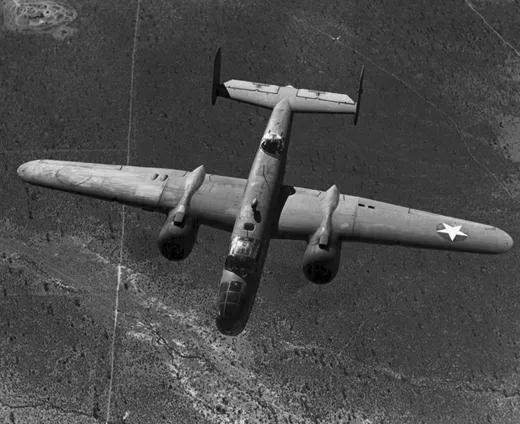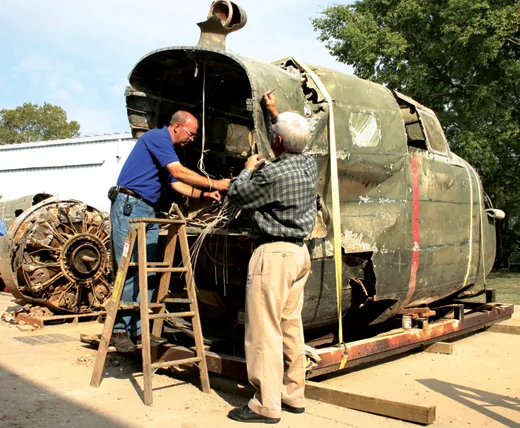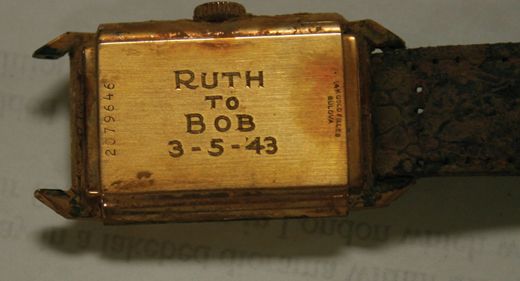Lake Murray’s Mitchell
For a B-25, it was a short flight and a 62-year layover.
/https://tf-cmsv2-smithsonianmag-media.s3.amazonaws.com/filer/restoration_631-jan07.jpg)
At about 10:45 a.m. on April 4, 1943, Bryce Lever was looking for fishing worms on the south shore of Lake Murray in South Carolina when he saw an airplane flying low, heading toward the water.
Katherine Townsend Tapp, 23, was strolling on the lake’s north shore when she saw the ailing aircraft, a B-25. She hurried to the home of Sewall Oliver, who had a speedboat that could be used in a rescue. Nearby, Martin Jones Jr., 10, also saw the aircraft descend; he yelled to his brother that one of the engines was out.
Martin had a sharp eye. After the B-25 had taken off from the Army Air Base outside Columbia, South Carolina, on a skip-bombing training mission over the lake’s island targets, its left engine had lost power. The base was a good six miles away, so Henry Mascall, the bombardier, urged pilot William Fallon to land on the lake. The airplane ditched about two miles west of Dreher Shoals Dam.
The crew climbed out onto the wings, then inflated a life raft and set it in the water. Sewall Oliver eventually rescued them all in his speedboat.
About seven minutes after impact, the aircraft began sinking. It finally ended up at the bottom of Lake Murray, at a depth of 150 feet—too deep for the U.S. Army Air Forces to salvage it. It was written off as a loss.
Growing up in Columbia decades later, Robert Seigler heard tales of the sunken bomber and was intrigued. In the 1980s, Seigler began researching the crash. Along with two partners, John Hodge and Bill Vartorella, Seigler formed the Lake Murray B-25 Rescue Project to get the aircraft out of the water. “This really is a hobby gone awry,” Seigler says today of his decades-long campaign.
The aircraft’s rarity made it worth the trouble. The B-25 Mitchell, a medium bomber used in both the European and Pacific theaters of World War II, was once plentiful: North American Aviation made nearly 10,000. Today, some 130 remain, and the one from Lake Murray is the third oldest. It is one of only four intact C models surviving, and the only B-25 that still has a bottom gun turret.
Seigler’s group had sonographers search for the aircraft in the early 1990s, but they had no luck. Then in 1992, a Navy unit took on the search as a training exercise. The following year, using side-scan sonar and the accounts of witnesses, including Katherine Tapp and Bryce Lever, the divers located the airplane in the 78-square-mile lake.
Subsequently, Seigler’s team spent more than a decade trying to raise money to attempt a salvage. Finally, in 2005, they hired Gary Larkins, with 68 salvages perhaps the world’s most successful aircraft retriever (see “Gary and the Pirates,” Feb./Mar. 1997). Starting September 10, Larkins began directing a salvage attempt. A barge was positioned above the airplane, and eight divers in two-man teams dove into the lake several times daily to inspect, clear silt, and secure the airplane. They worked as long as 18 hours at a stretch. At times, visibility was limited to inches. Larkins instructed the divers where and how to attach straps around the wings and spreader bars over the wings to distribute the weight for safe lifting. When all those were in place, the barge slowly raised the airplane and towed it to shore, just below the surface.
Just before midnight on September 19, hundreds of onlookers in boats and on land watched, spellbound, as a crane finally hoisted the airplane to the surface. A total of 800 gallons of fuel and water was pumped from the bomber before it was lifted clear of the lake. The aircraft was then dismantled, and the parts were cleaned, inventoried, and photographed.
Seigler’s group had arranged to give the B-25 to the Southern Museum of Flight in Birmingham, Alabama, and in December 2005 the front section went on display there.
Jim Griffin, the museum’s director, says that the B-25 is being preserved, not restored to pre-crash condition. The decision was based in part on the aircraft’s damage, which the museum judged too extensive to repair. When the bomber hit the lake, for example, the right engine had been torn off.
The cockpit is a different story. Artifacts from there turned out to be well preserved, and will be displayed with the B-25. Navigation charts and a 1943 section of Columbia’s The State newspaper are still readable. Also retrieved: four .50-caliber machine guns and one .30-caliber gun, buttons, parts of parachutes, bombsights, a tooth-marked olive drab pencil, headsets, earphones, a pair of leather driving gloves, a portable potty, radios, and the watch of copilot Robert Davison, inscribed “RUTH TO BOB 3-5-43.” “We found out last week that Ruth is still alive and was angry with Bob because he lost [the watch] after she had given it to him a month before,” says Griffin. “She still had a year to pay on it.”
Work on the rest of the B-25 is very slow. Volunteers are using dental tools to remove corrosion. “As we preserve various parts, they will be added to the display,” says Griffin. Eventually, the entire aircraft will be shown in an underwater-like setting, resting in a bed of sand.


